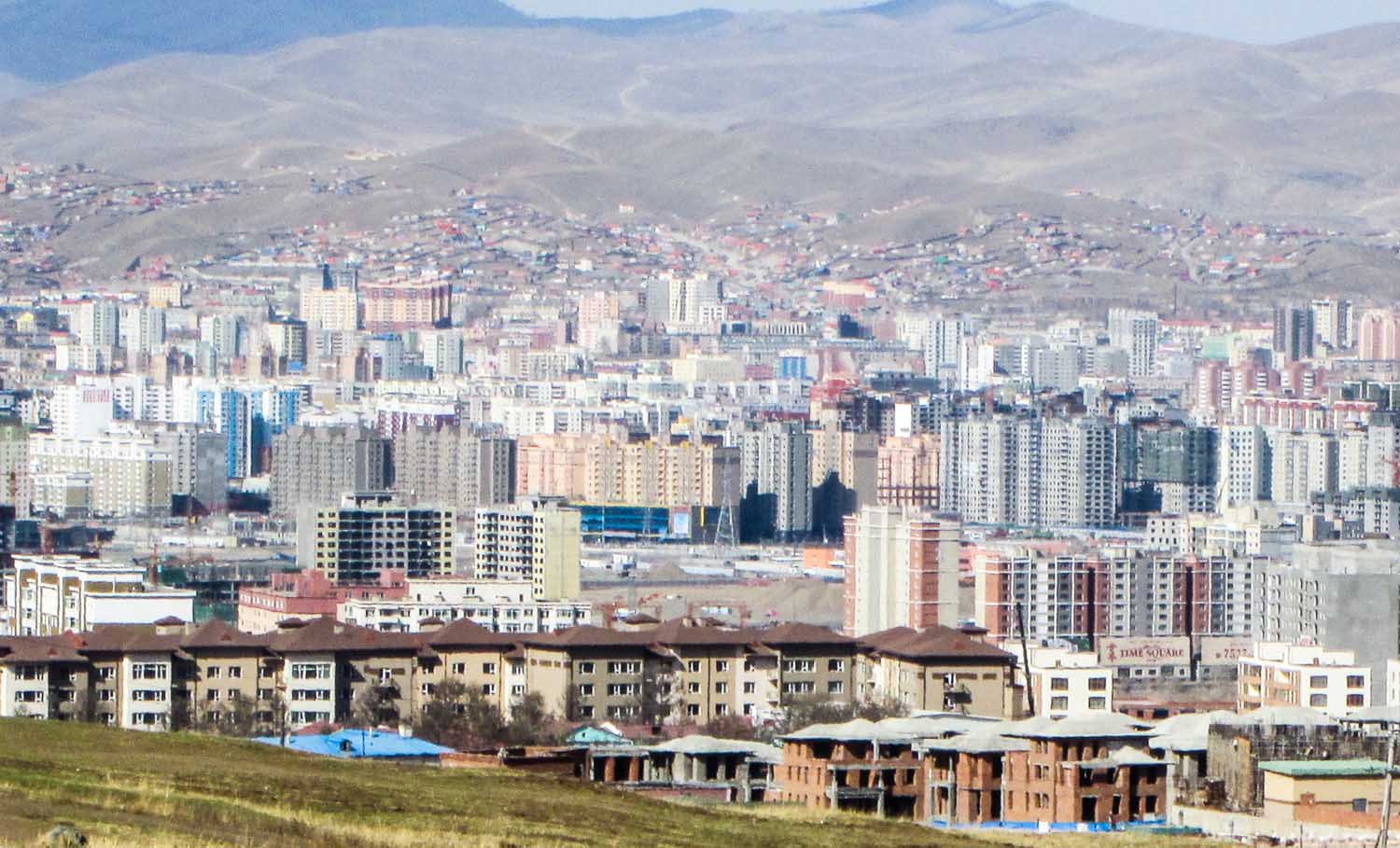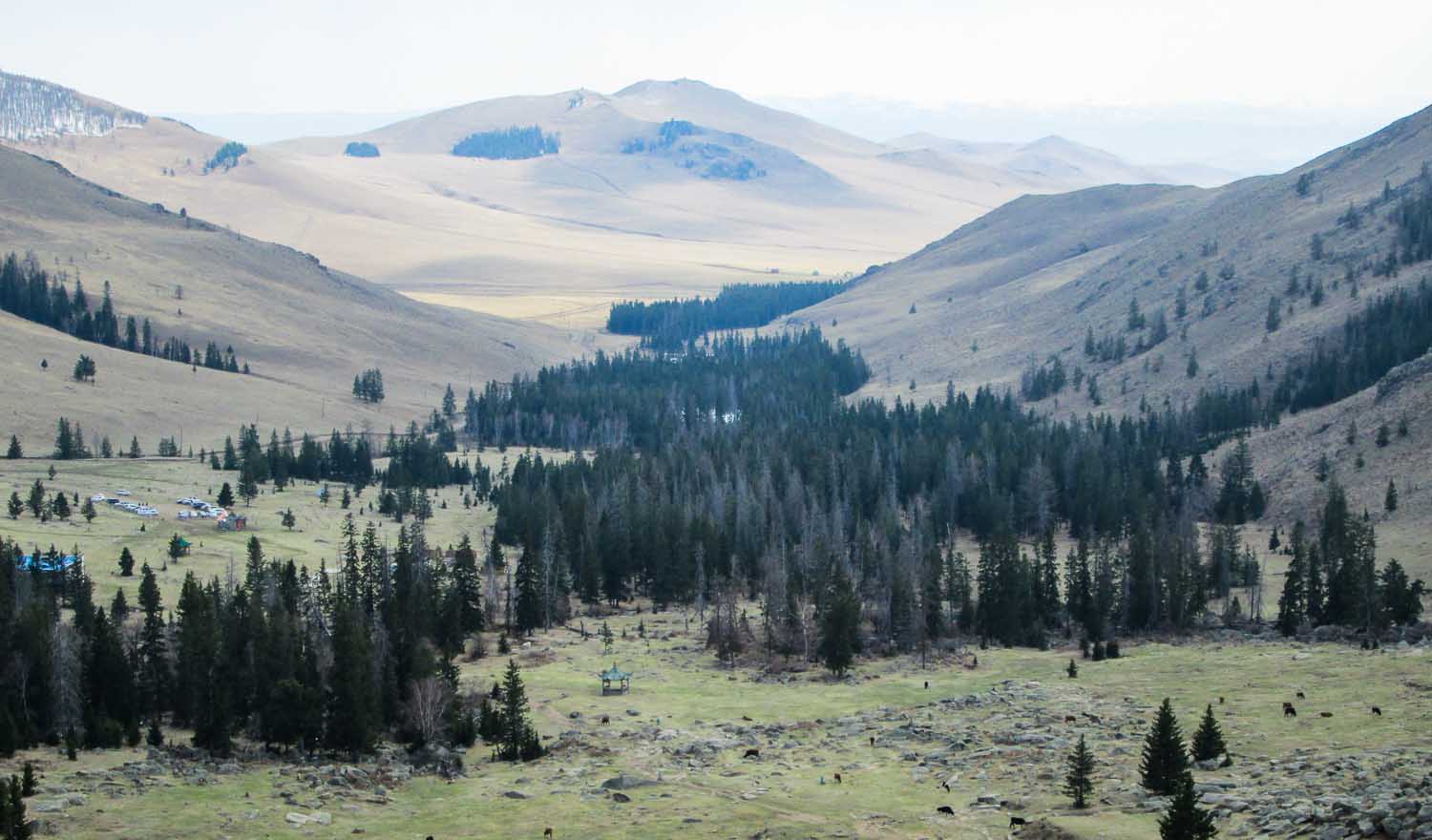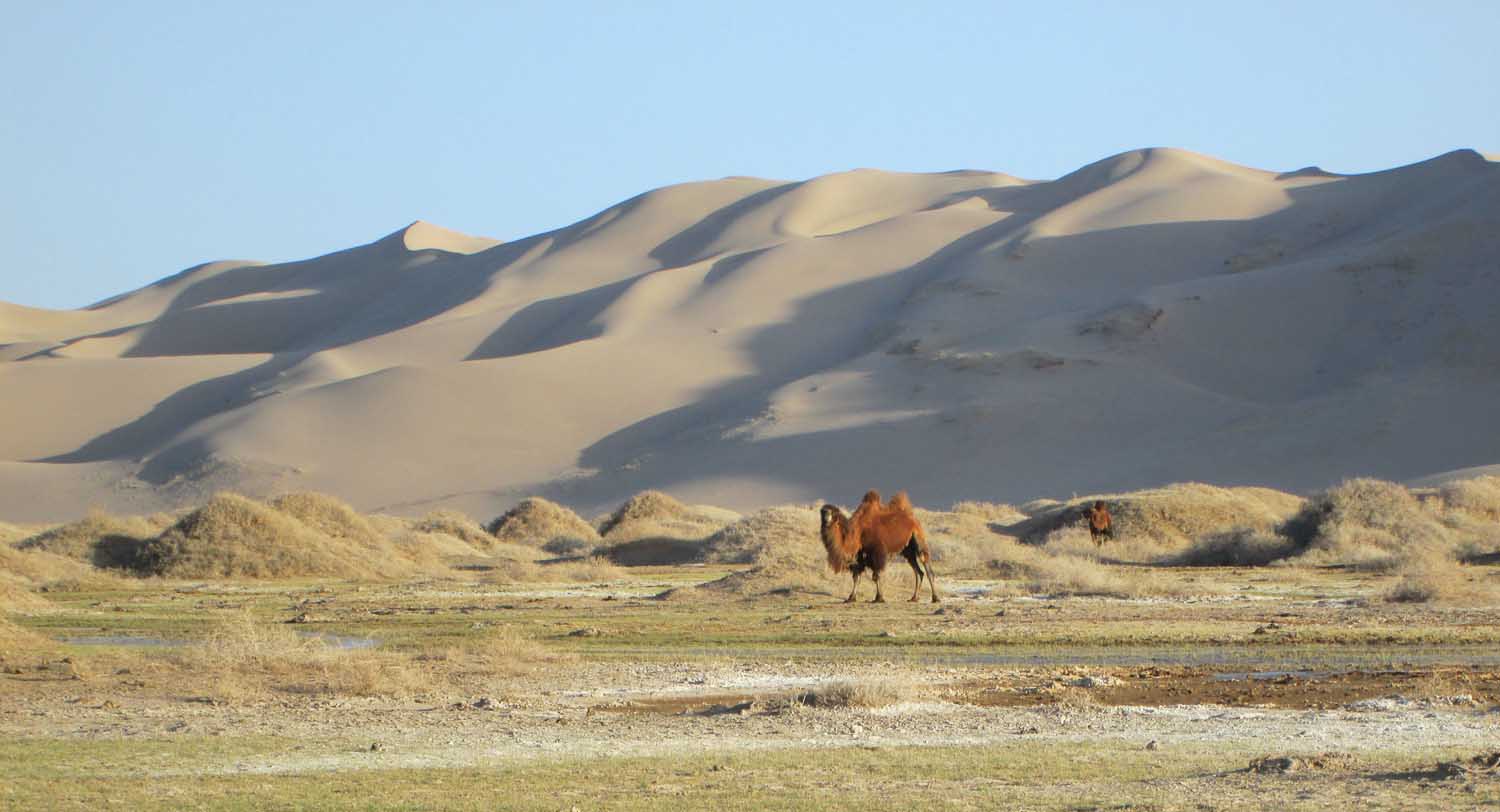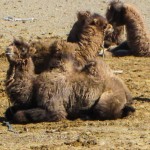Mongolia 2014: Gers and Skyscrapers
Every country likes to bask in the glory of its past, but Mongolia has taken Chinggis Khaan (yes, its spelled with two g’s and two a’s) to a new level. His image is everywhere; a huge statue that dominates the main square of the capital, his face carved on a side of a hill, a humungous statue in the middle of nowhere about 45 km away, as a brand of beer and two of vodka and his image on tee shirts. True, he created the largest empire in human history, but after killing most of his rival Mongolian chiefs and anyone else who came in his way. As the empire stabilized, he decreed religious freedom, built post stations and reduced taxes to promote trade and was the first ruler to recognize diplomatic immunity. His capital, Kharkhorum, had churches, mosques and temples and his governance was inclusive of diverse people. His son Ogedei and later progeny Kublai extended the empire from China all the way to Hungary. The Mongol Empire lasted about 160 glorious years, but Chinggis’s blood-line remained rulers in Central Asia and South Asia (Moghuls) for centuries, one even became a Dalai Lama.

Ulaanbaatar, the capital, sits in a valley at an elevation of 4,300 ft, surrounded by mountains that rise higher. Its cold, snowed three times during my visit in the last two weeks of April, not to mention an occasional dust storm. Winter temperatures are unbelievably cold, but not unbearably so because about 1.4 million people live in the capital, half the country’s population. It has had many names through history, Niislel Khuree was the last one before the triumphant communists renamed it Ulaanbaatar in 1924, meaning Red Hero. The city was developed in the Soviet style with huge wide rectangular boring buildings as government offices and similar, but taller apartment buildings. I did not see one single-family house. Newer office and apartment buildings have added architectural interest and, judging by the number of construction cranes peppering the skyline, many more are being built.
The city is laid out in concentric circles, with government and private offices in the center surrounded by apartment buildings that are in turn surrounded by shacks and Gers (indigenous circular tents). With no subway and many, many cars, the traffic is completely snarled during rush hours as people travel from the Ger and apartment rings to the office ring. Ulaanbaatar sounds like a far-away place, probably undeveloped, but it is modern and clean, especially compared to New Delhi, people are well-dressed, and the young are busy with their smart phones with ear buds. It offers the amenities of a capital city such as restaurants, malls, department stores, museums, theaters, and galleries.
The catch is that virtually all the signage is written in the Cyrillic script, adopted during the period of Soviet suzerainty. There are some signs that use the Latin script, Pub being the most popular word, followed by Bar, Restaurant, Bakery and, for some obscure reason, Irish, which comes before the other words. The Grand Khaan Irish Pub became my favorite watering hole, meeting and eating place. Centrally located, it offered Mongolian and Western food and drink, a Mongolian Rock or Rap band on some evenings and its clients were a mixture of Mongolia’s expanding middle class and expatriates working with the aid community and, importantly, in mining.

Ulaanbataar apartments
UB, as Ulaanbaatar is known, has many museums and art galleries. I visited most of them. Sadly, the Museum of Natural History, which houses the remains of dinosaurs, was closed for renovation and other museums in the Gobi desert with similar exhibits were not yet open as I was ahead of the tourist season by a few weeks. The National Museum of Mongolia provided a good overview of the country’s history; The Zanabazar Museum of Fine Arts had an outstanding collection of Zanabazar’s brass Buddhist sculptures and thangkas by him and others and masks; The Choijin Lama Temple Museum and the Bogd Khan Museum were temples and a palace dedicated to two brothers, the first a religious leader and the other the last king and also religious leader of Mongolia whose reign ended by his death in 1924. Both museums had fine sculptures, thangkas and masks, some by the redoubtable Zanabazar. These two Buddhist complexes were among the few that survived the Soviet purge of Buddhism and Buddhists in 1937 (see below); and the Gandan Monastery, the only old temple complex still in use, was destroyed in the Soviet purge, but rebuilt after communism’s collapse in 1990. The monastery area includes a few colleges of Buddhist philosophy, one is named the Zanabazaar Buddhist University.

Ulaanbataar Ger City
Zanabazar was an unusual person, considered the Michelangelo of Asia by locals. In addition to his artistic talent, he was a Buddhist leader during his life (1635-1723) and pioneered work in literature and philosophy. He invented the Soyombo script used in Mongolia before Cyrillic, based on scripts from India and Tibet. It is written vertically from left to right and now used for tattoos on young Mongolians. Indeed, “Zanabazar” is the local rendition of Sanskrit “Jnana-Vajra”, meaning thunderbolt of wisdom.
UB’s many art galleries offered traditional and modern paintings and sculpture, an obviously vibrant movement. I visited several and purchased a water-color on silk, a symbolic work in a traditional style by a young artist at the Mongolian Union of Artists, a holdover from the Soviet era.
I made three day-trips outside UB to: Mandshir monastery ruins, also destroyed in Stalin’s purge, but its high elevation overlooking a valley with forested mountains rising on the other side made for a good photograph. The museum housing its artifacts was closed; the enormous statue of Ginggis Khaan riding a horse, so large that visitors can take an elevator to the horse’s tail and walk to its head, which I did not do; and Terelj National Park with forested hills with a monastery for meditation set high up that looked like Tiger’s Nest, the famous temple in Bhutan.

View from Mandshir Monastery
Because of its mineral wealth in copper, coal and gold, Mongolia has been the fastest growing economy in the world for the past few years and is expected to grow at double-digit rates for the next few years. Its purchasing power parity GDP per capita is almost $8,000 and poverty has fallen to about a quarter of the population. It is landlocked and wedged between Russia and China, where most of its trade flows. Its income is too high to develop labor-intensive manufactures and level of skills too low for sophisticated fabrication. Its agriculture and tourist potential is limited by climate, which is congenial for only about 3 months in the year. With 44 million animals (goats, sheep, cattle, lamas, horses and camels) for 2.8 million people, a potential for exporting meat to China and Russia is touted as a potential, but these animals are kept in small herds spread over an area three times the size of France, making slaughter and processing uneconomic. Its best shot for future growth is to manage the commodity price cycle well and invest heavily in education to mine Mongolian minds in the future.
Geopolitically, wedged between rising China and unpredictable Russia, it is sucking up to the US as a “third neighbor” and also Japan and S. Korea. Its modern ties with India became closer when Mongolians studying in Tibet fled to India with the Dalai Lama, many settling in Kalimpong, near Darjeeling where I went to boarding school. Among those who fled Llahsa was an Indian from Ladakh who later became the Nineteenth Kushok Bakula Rinpoche, a senior Buddhist monk, and India’s ambassador to Mongolia in the late 1970s when he facilitated the Dalai Lama’s visit and arranged for Mongolian monks to study in India, aiding the revival of Buddhism.
Mongolia has a continental climate. Situated at an average altitude of about 5,000 ft surrounded by high mountain chains that block the wet winds, with rainfall averaging just 8” annually. Its winters are long with really cold temperatures and summer is warm and not long. But there are 250 sunny days a year, often with clear cloudless skies, making is known as the country of “blue sky”. In spring, it can be 70 F one day, snowing the next, or a freezing wind, as I discovered. A couple of small streams that I visited in the Gobi desert were still frozen so I had to walk on water for a couple of kilometers to view the gorge. A desert brings baking heat and searing sun to mind, but not in the Gobi. My first day was windy and cold. Because of the climate, over 90 percent of the country is grassland or shrub or desert, with very little other vegetation. About 8 percent is forested, mostly with pine, but not densely as far as I could tell. Less than one percent of the country is settled for living or agriculture.
I made a three-day foray south into the Gobi desert, traveling about 400 miles in a circle from Dalangadzad, where I flew. I traveled in a four wheel vehicle “off-road”, on tracks in the desert. But there were many tracks so how did the driver chose the right one every time without the help of a GPS? As he didn’t speak English, I don’t really know the answer, but he pointed to landmarks, which gave him the general direction. Anyway, we arrived at gorges, sand dunes and flaming hills, the main sights, without getting lost. Except for shrubs, the area was totally barren. The steppe-desert widened and narrowed, bordered by craggy, even more barren hills on both sides.

Gobi Sand Dunes
Animal herds broke the monotony every twenty or thirty miles, mostly sheep and goats, but some horses and double-humped camels. In the distance was a Ger where the owners lived. Occasionally, there was a lone Lama or a small herd of gazelles or Pikas that look like rats, but belong to the rabbit family, racing for cover. The driver kept awake by listening to Rap and Pop songs on the radio or talking on his smartphone. Yes, cell phones work in the middle of nowhere and are widely used in the countryside.
The remarkable sight was the sand dunes, mountains of them rising to about 1,000 ft and continuing for as far as the eye could see, bordered by higher craggy hills behind. We reached late in the afternoon after a long bumpy drive. Nevertheless, I hiked about half-way up a dune, one step forward, half back to get a feel for the sand and take in the view. The undulating golden sand stretched for miles. Below us were herds of horses and double-humped camels grazing in a swamp. Later, I was told that I should have climbed up to the top to see the depth of the dunes, like a sea of sand.
The gorges were interesting enough, especially as the streams flowing through them were frozen and I had to walk carefully not to slip to reach them. Unfortunately, the small museums by these gorges that house dinosaur remains were closed. The area around the red stone hills with sheer drops was where much of the dinosaur remains were found. The site was great for photography, but there wasn’t much to do there except perhaps hunt for fossils.
My other trip was for about 500 miles East to Kharkhorum, Chiggis Khaan’s capital, or rather its location, because even the remains were used to build Erdene Zuu Monastery, probably the most revered in the country. For this trip, we drove on a finished one-lane road that was not much trafficked except near UB. The vista en route was different from the Gobi of course, but also arid as the road wound through undulating bare hills that were just beginning to turn a little green and would become snow-capped higher mountains for a while and then hills again. A few herds of animals appeared every ten to twenty miles, less frequently some shacks near a gas station offering food and supplies and, even less frequently, a village, one of 331 in Mongolia according to my guide/driver.

Gobi Landscape
Actually, it was Chinggis’s son Ogedei who built the capital where his father had a supply base. Its centerpiece was his palace, but there were many religious structures as twelve religions were actively practiced. Adding to that religious discourse were scholars, artists and musicians from all the way to Europe, many captured during the empire’s expansion. Unfortunately, the capital didn’t have time to flourish because, within 40 years, Kublai Khaan moved his capital to Beijing, then named Khanbalik. A new museum near Erdene Zuu displays an easy to follow history of Mongolia and a model of ancient Kharkhoram.
Erdene Zuu monastery, the only site worth a visit in the area is in a high valley surrounded by snow-capped mountains in the spring. Altai Khan built it in 1586 as the first Buddhist monastery in Mongolia. In its hey day, it had more than 60 temples and a thousand monks. Stalin’s purge in 1937 destroyed all but three temples and many monks were killed or sent to gulags. Courageous locals saved many pieces of art, allowing it to open as a museum in 1965 and in 1990 for worship. It had a central temple flanked by four others, including one Tibetan in style. On the trip, I also visited Tovkhon Monastery founded by Zanabazar, also a shell of its former glory, and a fresh-water lake, Ugii, where many varieties of birds come to fish, but it was a cold and windy day and no birds were in sight. We silently ate lunch watching and listening to the waves hit the shore.
Mongolian’s spiritual practices were confined to shamanism, but after acquiring an empire, it’s people were exposed to other religions. Kublai Khaan was apparently partial to Buddhism, but it did not take told hold until the reign of a descendant, Altan Khaan in the late 16th Century when a Tibetan monk converted him, which helped the religion’s acceptance by the population. As recently as the 1920s, Bogd Khan was both the religious and secular leader of the country. The Stalinist purge in 1937 destroyed almost 700 monasteries and 30, 000 monks were killed and many more sent to gulags. After 1990, Buddhism has enjoyed a rapid revival and about 80 percent of Mongolians consider themselves Buddhists, but that number is suspect as young people don’t seem that inclined to spiritualism. Perhaps some older people are not that religious either as Mongolia ranks 83rd out of 177 countries in the Corruption Perception Index.
Nevertheless, Buddhism has influenced aspects of state policy such as Mongolia being the only declared nuclear weapons-free nation, and it has strict hunting laws and other protections for wildlife and the environment. A Grand Maitreya project to construct a 180 feet statue of Buddha, and an even taller stupa, perched on a hilltop outside UB, is soon to start in the hope that it will expedite Buddhism’s revival in Mongolia.
Despite a good chunk of the population being nomads, education is widespread, resulting in almost universal literacy. Herdsmen’s children are boarded in village schools when parents move for better grazing land. My English speaking guide/driver, who was in his early 20s, was from a herder family until 10 years ago and he had studied in such a boarding school. He was readying to take the TOEFL exam and leave for the US to study for an MBA. He was an exception because 80 percent of higher education students in Mongolia are women and they have a similar percentage of skilled jobs, giving them relatively more freedom and clout in society. They are following a tradition of women warriors and rulers. Perhaps economic independence accounts for a high divorce rate for a developing country.
In UB, I stayed with my friend Saha Meyanathan in a gated apartment complex in the ritzy suburb of Zaisan that had many such compounds and many more under construction in anticipation of Mongolia’s continuing economic boom. Saha and I had overlapped as doctoral students and later on staff at the World Bank. He had opened the Bank’s mission in the country and served as its manager for six years until he retired a few years ago. He remained in the country for personal reasons and has written a book about it “Portraits of Change” and made an accompanying documentary. He was kind enough to show me around UB, introduce me to friends and lend me his car and driver for the day trips outside of the city in which he joined me when he had the leisure.
He helped me design my itineraries for the longer trips into the country. On those trips I stayed in Gers, felt tents that are Mongolia’s traditional habitat and still used by nomadic herdsmen. Tourist Gers, which I assume have some modern facilities, were not open so I used guest-house Gers, used by local travelers and a few tourists as well. The tents had five or six small beds with basic bedding, a table to eat off and a naked hanging light bulb that was bright enough for eating and drinking vodka, but not enough for reading. The “toilet” was a wooden shed over a deep hole in the ground about 100 yards away and visits in the dark of night and cold air were fraught with obstacles I won’t go into. There was no running water—what little washing occurred was with bottled water. The owner’s Gers were more comfortable of course, complete with simple furniture and a TV.
In the Gobi, the owner had three Gers for travelers. By chance, one of them had an Indian traveler from New York who had just finished a masters degree at the Stern School of Business where I had taught a lifetime ago. Our guides mentioned an Indian couple in the Ger compound a few miles away. The two us drove over and chatted with the couple whose adventure included taking the Trans-Siberian Railway all the way to Moscow. The Ger host family in Kharkhorum was very gracious, provided a more comfortable and better-furnished Ger and made us dinner, breakfast and lunch to take with us.
Being a vegetarian, I did not get much insight into Mongolia’s cuisine, which is mostly meat, being herdsmen. The vegetarian dishes I tasted such as mo-mos (steamed dumplings), fried vegetable patty and noodles with a few slivers of carrots and peppers were pretty bland so I preferred Chinese and Western food, which was readily available in UB, but not in the country. Like any good tourist, I drank Chinggis beer and Chinggis Vodka. Locals consume a lot of vodka, and frown on tourists adulterating it with mixers. Saha introduced me to an upscale vodka, Chinggis Khaan, which was very good.


